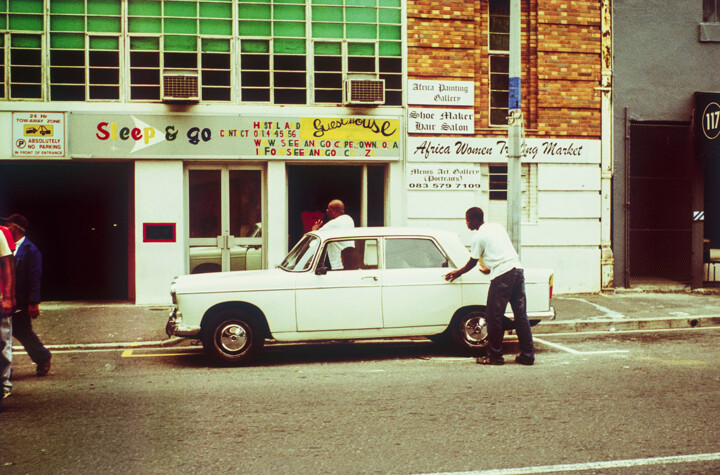



让我们知道您是否想看到这件艺术品的更多照片!
- 工作的背面 / 工作的一面
- 细节 / 签名 / 艺术品的表面或纹理
- 情境中的艺术品, 其他...
Street scene No.1 (2024) 摄影 由 András Nagy
更多信息
- 包装 (盒子或纸箱包装) 所有的作品都配有优质的承运方,经过严格的包装保护和已投保。
- 监控 跟踪订单,直到包裹交付给买方. 将提供跟踪号码,以便您可以实时跟踪包裹。
- 延迟 全球配送会在3-7天内送达 (估计)
- 不包括海关 价格不包括海关费用。大多数国家/地区对原创艺术品没有进口税,但您可能需要支付减免的增值税。海关费用(如果有)将由海关在抵达时计算,并由承运人单独计费。
更多信息
- 可追踪的在线真品证书 可以通过扫描插图的代码随时在线验证真品证书。
- 认证评级艺术家 专家研究一个艺术家的工作和职业生涯,然后建立一个独立的,可靠的平均价格值。平均价格价值座落在一个价格范围内的某一时期的艺术家。专家们也可能被要求建立一个更精确的估计为特定的工作。
更多信息
使用SSL证书进行100%安全付款 + 3D Secure.
更多信息
-
限量版 份数 : 50.
摄影,
电影摄影
/
数字打印
在纸上
- 可用份数 50
- 外形尺寸 高度 11.8in, 宽度 17.9in
- 艺术品状况 艺术品完好无损
- 是否含画框 此作品未装裱
- 分类 摄影作品 低于US$1,000 市
A series two images. Captured on 35mm Ektachrome slide film. Scanned with a Scanmate drum scanner in Nagya's digital lab. Prints made with Epson Ultrachrome ink on Tecco BTG 300 paper.
相关主题
András Nagy is a multimedia artist, born in 1972 in Budapest. His creative work is comprehensive and multifaceted. Photography, cinematography, and sound sculpture form a close-knit unity within his artistic repertoire. Throughout his career, he has photographed and filmed in numerous countries around the world. Since the 1990s, his works have been regularly featured in cinemas, galleries, and radio broadcasts.
His ars poetica revolves around thinking in processes. The power of images comes from the intense experience they convey, the act of becoming one with the subject in the moment. He primarily works with traditional silver-based materials, using film ranging from 35mm format to 4x5 large format. His works place great emphasis on impeccable technical quality. He scans his images with a special drum scanner that faithfully reproduces the diverse sensitivities of the film material.
András Nagy’s sensitive perspective is probably best known from his work as a cinematographer, for example in the feature films Bibliotheque Pascal, White Palms, or Eternal Winter. Besides creating moving pictures and constructed spectacles, he has also established a more liberated, peculiar photographic universe. Everyday scenes, locations, objects, which become highlighted by the gesture of taking the photograph. The meticulous compositions and the sometimes seemingly insignificant situations invite the spectators to reevaluate the relationships and interconnections, and take part in a peculiar dialogue.
The questions primarily target the subjects of the images: of whom, where, under what circumstances could they have been taken? The gaze searches for the familiar points of association until the time spent with the images raises our awareness to how the initial concepts must be replaced by a deeper, internal way of perception, the understanding of the symbols. Beyond the presence of light, the shadows also point to what is not included in the photograph, the source of the shadow itself. The bushes located on the side of a street or the verge of a field could be symbolically interpreted reaching even as far as the Biblical story of the burning bush, the origin of establishing a kind of moral standard. The human portraits, the contemplating, distant gazes, the steps, the anticipation, the kiss, the dance, the activities extrapolated from the flow of time and placed in a peculiar framework display the elevated contents hidden in the simplest of situations.
András Nagy is the flâneur of Benjamin and Baudelaire, a character wandering on the streets with his observant attitude, turning our attention to everyday situations, locations, objects, and events that we could encounter any day of our lives. The photographs taken on film, with a strictly analog method, do not only call for a disciplined work from the author but also invite a more immersed perception.









